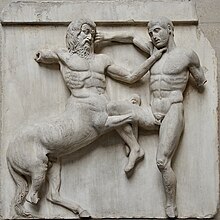
Back حقل المنحوتة (معمار) Arabic Metopalar Azerbaijani Метопа Byelorussian Мэтопа BE-X-OLD Метоп Bulgarian Mètopa Catalan Metopa Czech Metope Danish Metope (Architektur) German Μετόπη Greek
This article includes a list of general references, but it lacks sufficient corresponding inline citations. (May 2021) |

A metope (/ˈmɛtəpi/; Ancient Greek: μετόπη) is a rectangular architectural element of the Doric order, filling the space between triglyphs in a frieze[1][2][3][4]: 43 [5]: 43 , a decorative band above an architrave.[3] In earlier wooden buildings the spaces between triglyphs were first open, and later the free spaces in between triglyphs were closed with metopes[3][1]: 43 [5]: 43 ; however, metopes are not load-bearing part of a building[4]: 43 [5]: 43 . Earlier metopes are plain, but later metopes were painted or ornamented with reliefs[3][4]: 130 .[2][1] The painting on most metopes has been lost, but sufficient traces remain to allow a close idea of their original appearance.
In terms of structure, metopes were made out of clay or stone.[1] A stone metope may be carved from a single block with a triglyph (or triglyphs), or they may be cut separately and slide into slots in the triglyph blocks as at the Temple of Aphaea. Sometimes the metopes and friezes were cut from different stone, so as to provide color contrast. Although they tend to be close to square in shape[5]: 43 ,[1] some metopes are noticeably larger in height or in width[5]: 71 . They may also vary in width within a single structure to allow for corner contraction, an adjustment of the column spacing and arrangement of the Doric frieze in a temple to make the design appear more harmonious.
Some of the earliest surviving examples are stone metopes from a peripteral temple at Mycenae, ca. late 7th century BC, and painted clay metopes from Thermus, ca. early 6th century BC.[1] The high-point of relief sculpture on metopes is exemplified by the 92 metopes of the Parthenon, metopes of the temple of Zeus at Olympia,[1] together with the metopes of Temple C at Selinus.
- ^ a b c d e f g Cite error: The named reference
paulywas invoked but never defined (see the help page). - ^ a b Mish, Frederick C., ed. (1990) [1983]. Websters Ninth New Collegiate Dictionary – Metope (Collector's ed.). Norwalk, Connecticut: The Easton Press with the permission of Merriam-Webster Incorporated. p. 748.
- ^ a b c d Cite error: The named reference
dogarawas invoked but never defined (see the help page). - ^ a b c Cite error: The named reference
gardnerwas invoked but never defined (see the help page). - ^ a b c d e Cite error: The named reference
robertsonwas invoked but never defined (see the help page).